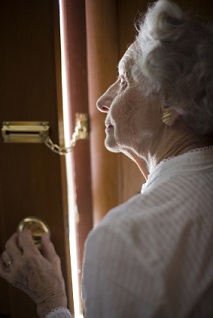

By: Melina Druga
securitysystems.net contributor
Tactics and strategies helping seniors remain safe in their homes and seniors.

Falling is the leading cause of injury among seniors in the United States.
No one wants to lose their mobility and independence. Unfortunately, every year that’s exactly what happens to so many senior citizens.
Among seniors age 65 and older, the leading cause of injury is falling. In fact, every year around 2 million seniors are hospitalized and around 20,000 seniors die as a consequence of falls.
Seniors also can be injured in other ways, both inside and outside the home. These injuries can be prevented, however, with a few modifications to the home.
Install the following outside the home to prevent falls and injuries.
If the senior citizen uses a cane, special tips are available for traction on the ice and other slippery surfaces.
Install the following inside the home to prevent falls and injuries.
In addition, add nonslip padding or carpet tape to rugs to prevent slipping and remove any clutter which could be a tripping hazard. If extension cords are in use, they should be placed along walls, not across the floor.
Install the following inside the bathroom to prevent falls and injuries.
In addition, all standing areas should have nonslip mats.
Install the following in and round stairwells to prevent falls and injuries.
In addition, remove clutter from the stairs. If the stairs are carpeted, inspect to be certain it is free of holes or other tripping hazards. There should be a color differentiation between the floor and the edge of the stairs.
Install the following inside the kitchen to prevent falls and injuries.
In addition, remove any unneeded objects from countertops and keep cabinets and drawers closed.
Preventing fires is equally as important as preventing falls and injuries. Be sure to install smoke detectors and have fire extinguishers on hand. For more information on fire safety, visit
Medical alarms are another option for seniors who want to maintain independent living. For a monthly fee, users can send an alert to 911 in the event of a fall or other emergency. The user is required to the device.
Advantages:
Over and above home safety tactics are health strategies for avoiding falls. Most falls can be prevented, and using the above as well as these health basics help seniors from falling:
The following is a list of exceptional websites where you will find more information on senior home safety.
Crime prevention and personal safety information for older Americans: www.ncpc.org/topics/by-audience/seniors
The Consumer's Guide to Home Safety for Seniors www.csa.us/HomeSafetyGuide.aspx
Caregivers' Resources www.usa.gov/Citizen/Topics/Health/caregivers.shtml
Falls Among Older Adults: An Overview www.cdc.gov/homeandrecreationalsafety/falls/adultfalls.html
Home Safety Self Assessment Tool agingresearch.buffalo.edu/hssat/assessment/index.php
Assistive Devices and Helpful Products to Prevent Falls agingresearch.buffalo.edu/hssat/assistive_devices_and_helpful_products.pdf
Improving Home Safety for Seniors www.ext.colostate.edu/pubs/consumer/09913.html